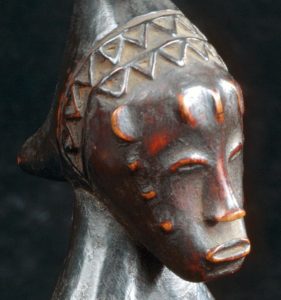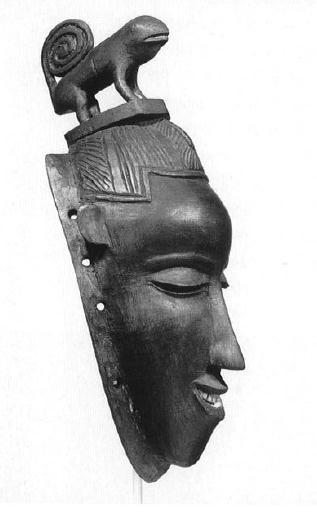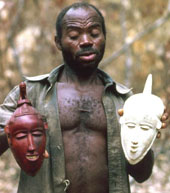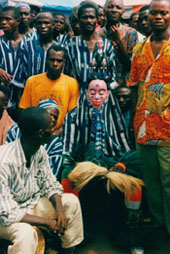
The Courtauld’s loom pulley most likely depicts a specific type of entertainment mask in miniature form. Looking at the loom pulley from an anthropological perspective can inform us about Guro masquerade traditions.
This object is clearly linked to several interesting processes of material, spiritual, and physical transformation. As across much of West Africa, Guro wood carving is a male dominated and specialised form of craftwork.
The Guro people of Côte D’Ivoire have a number of masquerade traditions, performed for both entertainment and religious purposes. This mask was made for the Sauli entertainment masquerade which is danced in commemoration of a beautiful woman. Master carvers produce the wooden masks used in these performances and it is likely that in the past these same craftsmen also made carved loom pulleys. Like The Courtauld’s carved loom pulley, this mask, dating from the mid-1970s, depicts a woman’s head surmounted by a chameleon.
Today Guro master carvers mainly make the wooden head masks used in performance. In the past they also used their skills to carve decorative loom pulleys and spoons.
A Male Activity

Carving is distinct from everyday occupations of farming and hunting. Guro carvers work away from their village homes at secluded, sacred spots in the nearby bush where they won’t be disturbed by women or children. Working in the forest, the carvers harness the power of the bush to transform the material into intricately carved masks. Craftsmen fell the trees they need for carving. The process of carving, staining and painting objects is often several days’ work and imbues carvings with the power of the forest. Such is the power that, outside of performances, women and children are not allowed to touch or see masks.
Masks are exclusively worn by men to dance a range of different types of masquerades – some are purely for entertainment, while others are religious. Guro head masks are combined with hand woven cloths to create colourful costumes that cover and disguise performers. When worn by a skilled dancer these costumes are part of the spiritual and corporeal transformation of the performer. Upon donning the costume a performer’s everyday identity is eclipsed and he comes to embody the spirit of the masquerade.
This vitality is reflected in the Guro language which defines a masquerade as a complete living entity comprised of spirit, costume and performance. Religious masquerades are believed to be particularly powerful and pose a danger to women who are forbidden from attending these performances. Women can, however, watch entertainment masquerades, such as the Sauli masquerade upon which The Courtauld’s loom pulley is based.
From the carver’s sacred grove to the masquerader’s performance, Guro carving and masking are male domains where gendered power is involved in a series of intimate transformations. These processes of transformation are both material and spiritual, hewing beautiful objects from wood and metamorphosing men into powerful masqueraders.
Back to West African Loom Pulley



